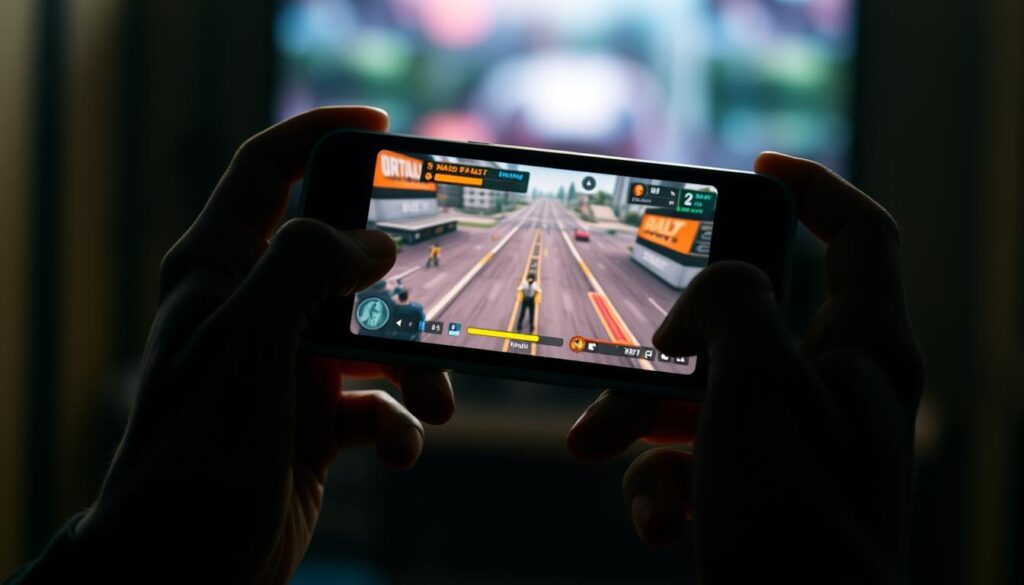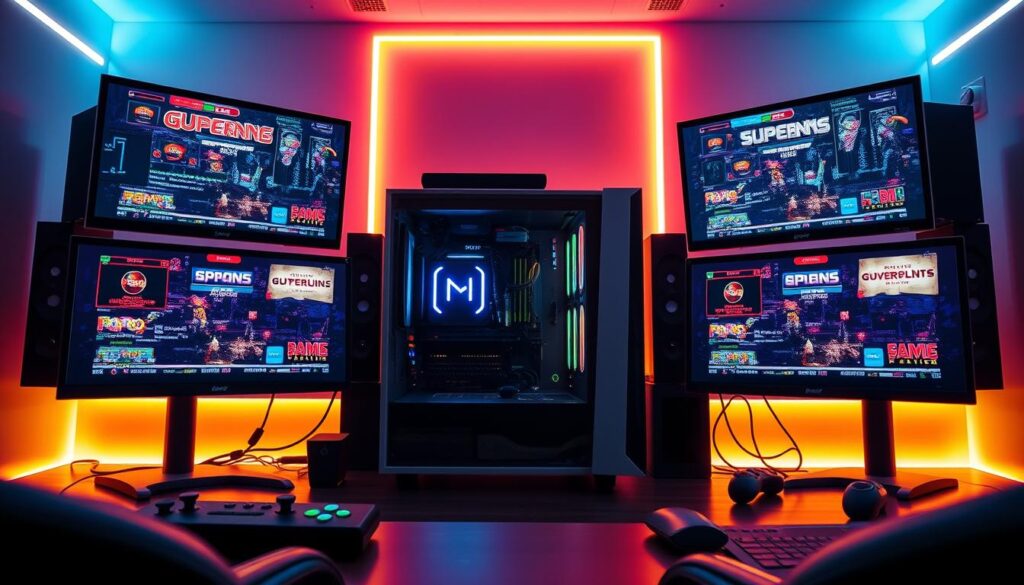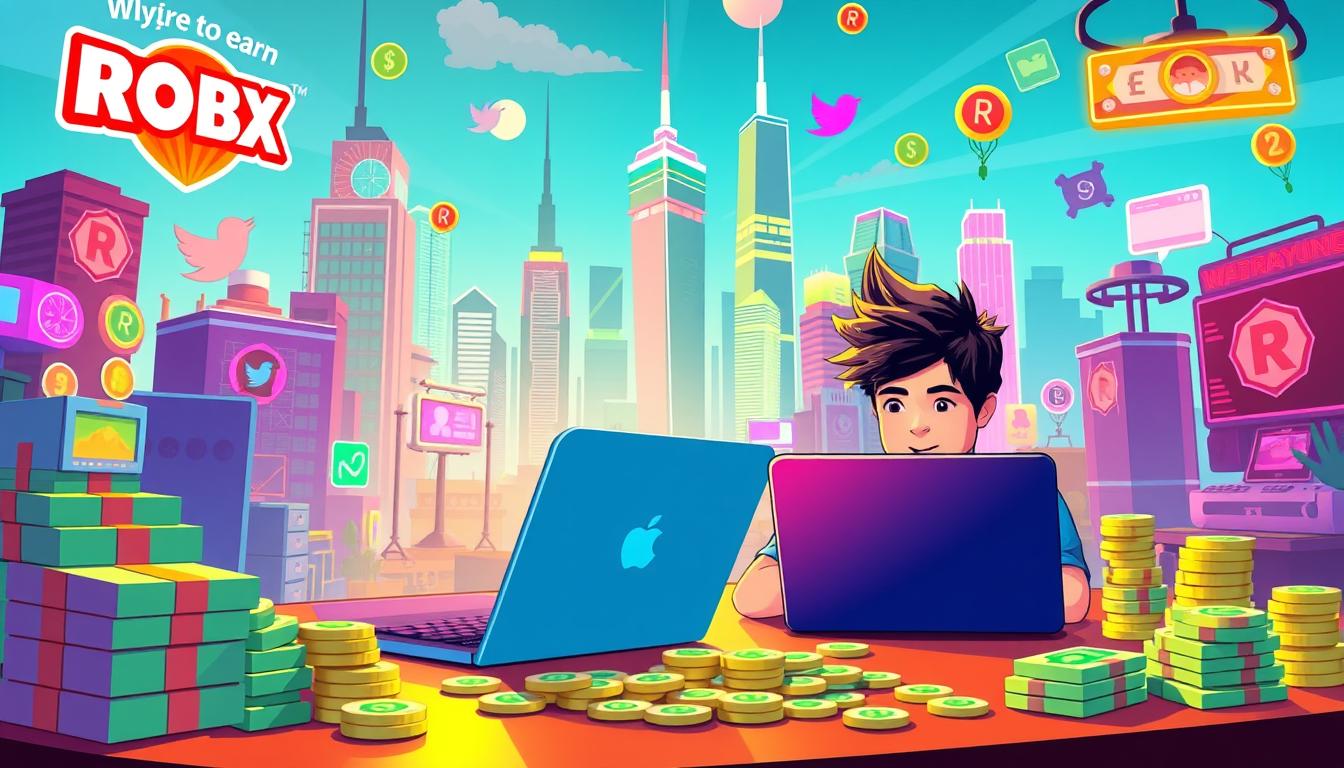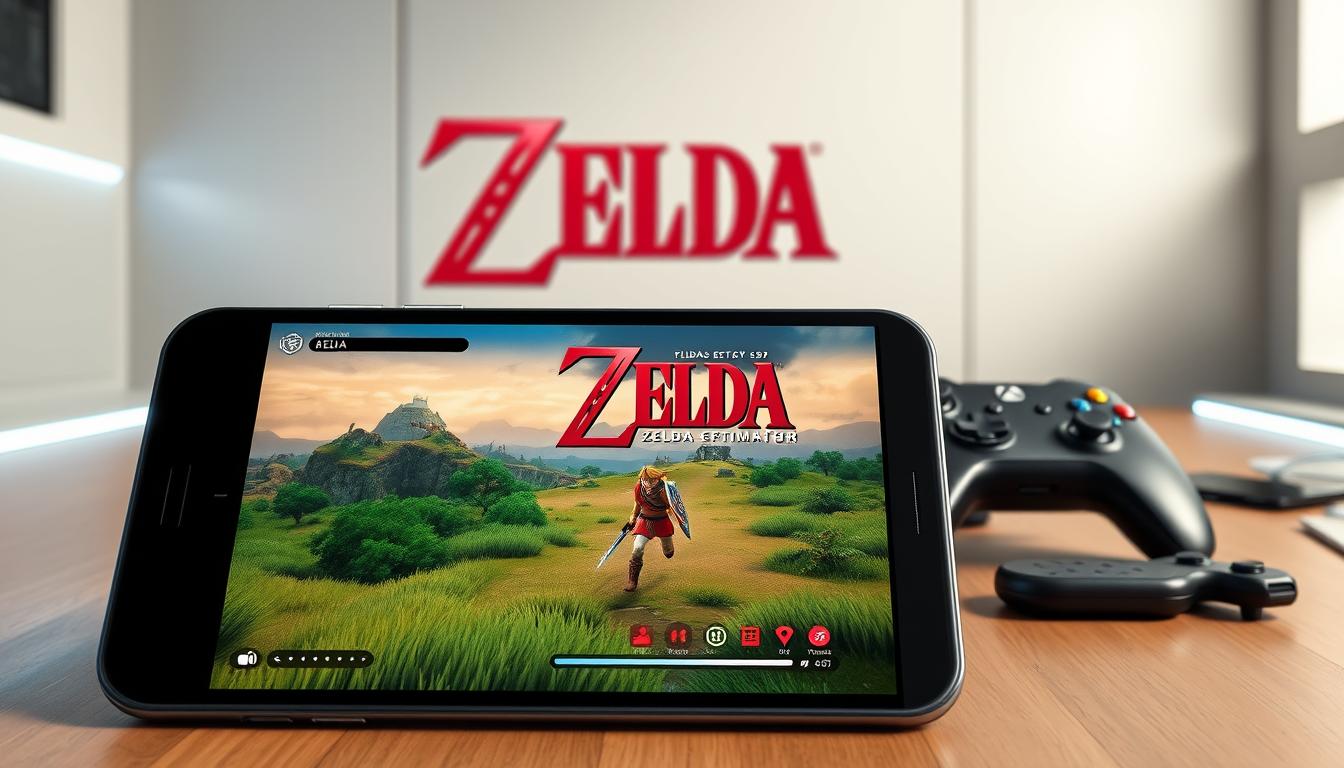Anúncios
Ever wondered why some gamers seem to play perfectly on their phones while others face input lag? Mobile gaming is getting more popular, but slow phones can make it tough. Luckily, new emulators are here to help. They cut down on input lag, making games smoother and more enjoyable.
This guide will show you the top emulators for better mobile gaming. Even if you have a budget phone, these tools can make a big difference. Get ready to take your mobile gaming to the next level.
Understanding Input Lag in Mobile Gaming
Input lag is the time gap between when you do something and when it shows up on screen. It’s key in mobile gaming. This delay can really affect how well you can play and enjoy the game. Smartphones with slower processors often have more input lag.
Anúncios
Hardware issues play a big role in input lag. Older or less powerful devices can’t handle inputs fast, causing delays. If games aren’t made for certain devices, it gets even worse. This makes playing games slow and can make it hard to keep up in fast games.

Why Emulators are Essential for Better Performance
Emulators are key for better gaming on devices that struggle with native games. They create a virtual space for games meant for more powerful devices. This is vital for keeping games running smoothly on different devices.
Anúncios
Using emulators boosts graphics and makes games more responsive. With the right settings, gamers can cut down on input lag. This is crucial for smoother gameplay. It lets users adjust settings for the best performance on their hardware.
Emulators also let gamers play games not available on their devices. They support games from many gaming consoles. This makes them essential for gamers wanting to enjoy a wide range of games, even with limited hardware.

Top Emulators to Reduce Input Lag on Weak Phones
Looking to boost gaming on your phone? The right emulator can make a big difference. Here are the top picks, each designed to cut down input lag for a smoother play.
Dolphin Emulator
Dolphin Emulator is known for its wide game support and top-notch performance tweaks. It lets you tweak graphics for better performance on weaker phones. This makes Dolphin a great choice for playing GameCube and Wii games on mobile.
PPSSPP
PPSSPP is all about giving the best PSP gaming experience. It has many performance boosts to cut down input lag. You’ll see less delay and smoother play, even on phones with limited power.
RetroArch
RetroArch is a multi-console emulator that does it all. It supports games from many platforms, fitting different user needs. With its customizable settings, RetroArch optimizes for weaker phones, reducing input lag.
Features to Look for in an Emulator
When looking for the perfect emulator, it’s key to focus on certain features. One important thing is how well the emulator works with different platforms. A good one should let you play many games, no matter what device you have.
Also, checking out the performance settings is crucial. These options let you adjust the emulator to fit your device and how you like to play. This way, you can make your gaming experience just right for you.
Compatibility with Different Platforms
How well an emulator works with different platforms is very important. Many emulators support big names like Nintendo, Sega, and Sony. This means you can play lots of games, making your gaming experience richer.
The more platforms an emulator supports, the better it is for everyone. It lets you enjoy a wide range of games, no matter what you’re using.
Configuration Options for Performance
Having good configuration options is a big plus. These let you tweak settings like resolution, frame rate, and input. This helps make the emulator work better on slower devices.
These tweaks can make your games run smoother, even on less powerful machines. Plus, performance hacks can make games faster and reduce lag. This ensures your gaming is always smooth and fun.
Best Practices to Optimize Emulator Settings
Improving emulator settings is key to better gaming. Tweaking graphics and performance can make a big difference. Finding the right mix of visuals and speed is crucial for smooth play on slower devices.
Adjusting Graphics Settings
Changing graphics settings is a big deal. Lowering the resolution and turning off fancy features can make games run smoother. Here’s how you can get better performance:
| Graphics Setting | Impact on Performance | Visual Fidelity |
|---|---|---|
| Resolution | Lowering resolution improves frame rates | Potential loss of sharpness |
| Texture Quality | High settings can cause slowdowns | More detailed graphics |
| Shadows | Disabling shadows increases FPS | Less realistic visuals |
Utilizing Performance Hacks
Using performance hacks is another great way to boost emulator speed. Turning on dual core support or tweaking CPU settings can cut down on lag. These tweaks help match your device’s power:
- Enable dual core for better processing power.
- Adjust CPU emulation to match the game’s requirements.
- Activate frame skip to maintain a stable FPS.
Hardware Requirements for Smooth Gameplay
Gaming performance depends a lot on a smartphone’s hardware. Each emulator needs certain specs to work well. A good processor, especially a multi-core one, is key for handling tough games.
A strong GPU is also crucial. It helps with high-quality graphics and smooth gameplay.
For better gaming, look for smartphones with the latest specs. Android 9 or newer with Snapdragon 700 series processors or better is a good start. These specs help with fast frame rates, low lag, and a smoother game.
| Smartphone Specifications | Recommended for Optimal Performance |
|---|---|
| Processor | Multi-core (Snapdragon 700 series or better) |
| Operating System | Android 9 or higher |
| RAM | At least 4GB |
| GPU | Adreno 600 series or comparable |
Comparison of Popular Emulators
Looking at emulators shows big differences, especially in how well they work with different consoles. Each one is made for a specific console, with special features and tweaks. For example, Dolphin and PPSSPP are made for GameCube/Wii and PSP games, respectively.
Emulators for Different Console Generations
There are many emulators, each for a specific console generation. How well an emulator works depends on its ability to mimic the original hardware. This ensures a smooth gaming experience. Here are some well-known emulators:
| Emulator | Supported Console | Performance Features |
|---|---|---|
| Dolphin | GameCube/Wii | High frame rates, excellent graphics options |
| PPSSPP | PSP | Enhanced textures, adjustable resolution |
| RetroArch | Multiple (various) | Multi-platform support, shader options |
Performance Differences
When we look at how well emulators perform, things like frame rates and how well they handle input are key. Some emulators run smoothly even on less powerful devices. This makes playing games better.
The table above shows how emulators are made for different consoles and their special features. Knowing these differences helps users pick the best emulator for their games. This makes gaming more fun.
Common Issues with Mobile Emulation
Mobile emulation can make gaming better, but it has its own problems. Players might face issues like frame drops and audio latency. These can ruin the fun and make games hard to play. Knowing about these issues helps players find ways to fix them.
Handling Frame Drops
Frame drops happen when games don’t run smoothly, often because of weak processing power. This can make fast-paced games hard to enjoy. To fix this, try these steps:
- Lower the graphics settings to use less power.
- Update your emulator to get better performance.
- Close apps you’re not using to free up resources.
Audio Latency Problems
Audio latency is when game sounds don’t match what’s happening on screen. This can make games feel off, especially in timing-sensitive games. Here’s how to fix it:
- Change your audio settings in the emulator for better sync.
- Try using wired headphones instead of Bluetooth.
- Keep your device clean by clearing cache and closing unused apps.
Community Recommendations for Enhancing Performance
The gaming community is key in sharing tips for better emulator performance. Newcomers can learn from experienced users’ knowledge. This shared wisdom helps in making gaming smoother and more enjoyable.
Tweaks from Experienced Emulator Users
Experienced users have gathered many emulator user tips to boost gameplay. These tweaks include:
- Adjusting frame skip settings for smoother gameplay.
- Modifying resolution options to balance visual quality with performance.
- Disabling unnecessary background processes on the device for optimal resource allocation.
- Employing custom shader settings for enhanced graphics without compromising speed.
These tweaks improve how fast and clear the game looks. Being part of community forums keeps you updated with new tips and tech.
Exploring Lesser-Known Emulators
The world of gaming keeps changing, and many gamers use well-known emulators like Dolphin and PPSSPP. But, there are many other emulators out there that are just as good. These lesser-known emulators offer special features for different gaming needs, making mobile gaming even better.
These emulators have unique features that cater to specific games or hardware needs. They can improve graphics, make controls better, or cut down on lag. By looking into these alternatives, gamers can find a wide range of options to enhance their gaming experience.
Here’s a look at some notable lesser-known emulators and their special features:
| Emulator Name | Platform Compatibility | Unique Features |
|---|---|---|
| ePSXe | Android, Windows, Linux | Advanced graphics enhancements, customizable controls |
| Drastic | Android | Full HD graphics, save state functionalities |
| Citra | Windows, macOS, Linux | 3D rendering capabilities, touchscreen optimization |
The Importance of Updates and Support
Keeping up with emulator updates is key for a great gaming experience. Regular software support keeps emulators running smoothly and adds new features. Developers work hard to improve performance, making games run better on different devices.
Why Frequent Updates Matter
Regular updates are crucial for better emulator performance and game compatibility. Look for emulators with active developers, showing their commitment to ongoing support. Here are some reasons updates are important:
- Patching Bugs: Updates fix bugs that can ruin your game.
- Enhancing Compatibility: New updates add support for more games, giving you more to play.
- Introducing Performance Improvements: Optimizations make your gaming experience better.
Choosing an emulator with strong software support is crucial for a smooth gaming experience. Teams that actively develop their emulators aim to give users the best gaming time.
Alternatives to Emulators for Playing Games on Weak Phones
Virtual emulators are a common way to play classic games on phones. But, those with weaker phones might look for other options. Native mobile game ports are a great choice. They offer games that work well on lower-end phones, giving a similar feel to traditional emulation.
Many game developers make their games for smartphones. This means you can play games without needing a lot of power. You can find these games in app stores. They often have simpler graphics and controls, making them easier to play on weaker devices.
Cloud gaming services are another good option. Services like NVIDIA GeForce NOW and Xbox Cloud Gaming let you stream games to your phone. This way, your phone doesn’t have to do all the work. It’s a great solution for those who want to play games without worrying about their phone’s performance.
| Alternative | Pros | Cons |
|---|---|---|
| Native Mobile Game Ports |
|
|
| Cloud Gaming Services |
|
|
In summary, while emulators are popular, there are many other ways to play games on weak phones. By choosing wisely, you can find lots of fun games to play, no matter your phone’s specs.
Tips for Managing Game Storage and ROM Files
Managing your game storage well is key for a smooth gaming experience. If your ROM files are all over the place, it’s hard to find your favorite games. Start by organizing your ROMs in a clear way. This means grouping them by console or genre.
This makes it much easier to find and play games without any trouble.
Also, focus on how you manage your ROMs. Always have backups of your ROM files in a safe spot. This is because devices can sometimes lose data, and you don’t want to lose your games.
Get rid of any ROMs you don’t use or have duplicates. This frees up space in your game storage. Regularly cleaning out your files keeps your storage running smoothly.
Remember, there are legal rules about using ROMs. Only use ROMs for games you legally own. Knowing this helps you enjoy gaming more and avoids legal problems.
Playing Online vs Offline: Impact on Input Lag
It’s important to know the difference between online and offline gaming to improve your experience. Online gaming often deals with connectivity issues and server delays. These can make it harder for your actions to be registered quickly.
Latency is a big problem, affecting everything from accuracy to response times in games. This is especially true in competitive games.
Offline gaming, however, is more stable. Since everything happens locally, there’s less chance of network delays. This means your actions are more immediate, which is key for fast games.
Players who love competitive games might prefer offline for better response. But, those who enjoy social gaming might choose online despite the lag. To get the best gaming experience, learning how to optimize your settings is helpful. Guides like how to optimize settings for mobile can help improve performance in both online and offline games.
Gauging Emulator Performance on Different Devices
For gamers, knowing how emulators perform on different devices is key. Emulators work better on high-end phones than on cheaper ones. This is because of the phone’s power, memory, and graphics.
Let’s look at how three phones compare: a top model, a mid-range one, and a budget phone. Their specs show how well they can run emulators.
| Device Type | Processor | RAM | Graphics | Emulator Performance |
|---|---|---|---|---|
| Flagship Smartphone | Snapdragon 888 | 12 GB | Adreno 660 | Excellent |
| Mid-Range Device | Snapdragon 750G | 8 GB | Adreno 619 | Good |
| Budget Model | MediaTek Helio G90 | 4 GB | Mali-G76 | Fair |
This comparison shows that emulator performance varies with phone choice. High-end phones offer top gaming with little lag. But, mid-range and budget phones might not perform as well. So, picking the right phone is crucial for a great gaming experience.
Future of Mobile Emulation
Technology keeps getting better, and mobile emulation is no exception. We can expect big changes in how games work on slower phones. This is thanks to better mobile processing and graphics.
Knowing what’s coming helps us see how mobile emulators will get better. This is exciting for gamers who want top-notch experiences on their phones.
Trends to Look Out For
- Increased Mobile Processing Power: Mobile devices are getting more powerful. Emulators will use this to make games run smoother.
- Advanced Graphics Technology: New graphics tech will make games look better on emulators.
- Cloud Gaming Services: Cloud gaming could change mobile emulation. It might let games run on servers, not just phones.
- Cross-Platform Compatibility: We might see more games work on different platforms. This could make gaming easier for everyone.
Conclusion
This article has shown how emulators help gamers with slower smartphones. They make games run smoother by reducing input lag. Emulators like Dolphin Emulator, PPSSPP, and RetroArch offer advanced features to improve your gaming.
Mobile gaming keeps getting better, and knowing how to set up emulators is key. By optimizing settings and managing storage, you can boost your gaming performance. This makes mobile gaming more enjoyable.
Every second matters in gaming, and the right emulator can change your experience. With the right emulator, even slow devices can offer great gaming. Start using emulators to make your gaming sessions better today!
FAQ
What is input lag and how does it affect mobile gaming?
Input lag is the delay between when you press a button and when the game reacts. On older phones, this delay is more noticeable. It can ruin the fun of playing games.
How can emulators reduce input lag on weaker smartphones?
Emulators make games run better by tweaking settings. They help manage resources well. This makes games smoother and graphics better, even on slow phones.
What features should I look for when selecting an emulator?
Look for an emulator that works with many games. It should have easy-to-use settings and let you customize games. This makes it better for your phone and your play style.
What are some best practices for optimizing emulator settings?
To get the best out of an emulator, adjust graphics settings. Lowering the resolution and turning off fancy graphics can help. Also, try performance hacks like dual-core support.
What hardware specifications are needed for optimal emulator performance?
For great emulation, your phone needs a fast processor and good graphics. Android 9 or higher is best. A Snapdragon 700 series processor or better is ideal for tough games.
What common issues arise during mobile emulation?
Frame drops and audio latency are common problems. They happen when the phone can’t keep up or the emulator isn’t set right. This makes playing games frustrating.
How can the gaming community help improve emulator performance?
The gaming community shares tips and tricks. They talk about settings, hardware, and special tweaks. This helps everyone get better performance from their emulators.
Are there lesser-known emulators worth trying?
Yes, there are hidden gems out there. They might have cool features or work better with certain games. Trying new ones can lead to better gaming on your phone.
Why are frequent updates important for emulators?
Updates fix bugs and add new features. They make emulators better and more compatible. Choosing emulators that get updated often means better gaming.
What alternatives exist for playing games on weak phones without using emulators?
You can play native mobile games or use cloud gaming services. These options don’t need as much power from your phone. They offer a different way to play games.
How does playing online impact input lag compared to offline gaming?
Online games can have more lag because of network issues. Offline games usually have less delay. This makes offline games smoother.
How does performance vary between flagship and budget smartphones for emulation?
Flagship phones do better with emulation because they have more power. They have better processors, more RAM, and graphics. This means a better gaming experience.
What trends should users watch for in mobile emulation?
Look out for better processing power, graphics, and cloud gaming. These advancements will make emulators work better on slower phones in the future.




